Traditional selling is dead. Simple, straightforward selling no longer cuts it for buyers. Today, sales teams win B2B deals by creating exceptional buyer experiences. We cover what defines the buyer experience and how to make yours great.
[This post was originally published in April 2019 and has been updated for 2021].
Think about how traditional selling works. In its simplest form, sales reps identify customers with a problem that your product or service solves. Your sales reps use presentations, phone calls, and even in-person meetings to convince the buyer that they need what you’re selling. Every sales rep's action is an effort to drive the deal forward and get the contract signed.
Today’s B2B buyer, however, is remarkably different from the under-informed buyer of the ‘80s and ‘90s. Buyers do their own research long before reaching out to a sales rep and defining their own solutions.
Research from Gartner has shown that as information sources have grown, sellers’ influence over buyers has shrunk.
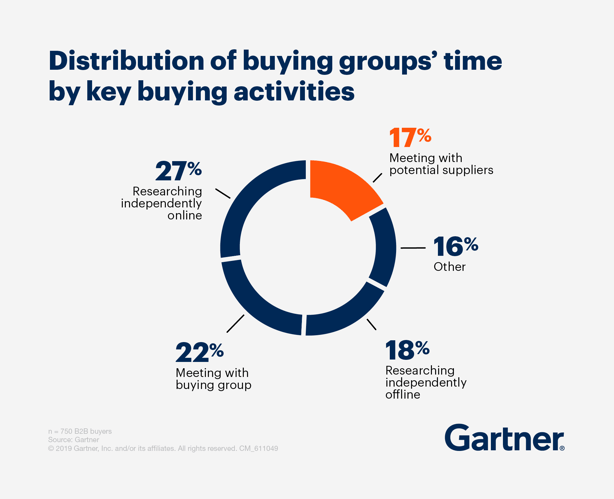
Source
B2B buyers spend just 17% of their time meeting with potential suppliers. The pressure is on for sellers to make that shrinking window of time count.
Everywhere you turn, businesses are adopting a more user-centric approach. The best phones, cars, websites, and apps train people to expect delightful user experiences. The same principle applies to the buyer experience in the B2B space: Prospects want a frictionless, delightful experience that feels tailored to their needs and pain points.
Selling today requires a relentless focus on the buyer experience. It’s critical that sellers understand why their customers buy, and craft a journey reflecting buyers’ needs, expectations, and motivations.
Table of Contents
- What Is the Buyer Experience?
- How Has COVID-19 Impacted the Buyer Experience?
- 7 Benefits of a Great Buying Experience
- Why Do You Need to Focus on the Buying Experience?
- How to Improve Your Buyer Experience
What exactly is the buyer experience?
We can define buyer experience as to how your ideal buyers experience the process of making a purchasing decision in your market.
The first thing to understand here is that the buying experience should really be understood from the buyer’s perspective. Only the buyer can tell you the steps they must take to get to purchase, what they need at each step and their satisfaction levels throughout the experience.
What does the buyer want?
According to Scott Albro, these are what buyers want when buying something:
- Simplicity: Buyers are 86% more likely to buy during a simple experience
- Relevance: 64% of buyers cite that “understanding the customer” is the most important factor for them
- Information: 95% of buyers prefer brands that provide content throughout the buying process
- Low Risk: “Reduced financial risk” is cited as the third important factor by 54% of buyers
- Control: 70% of the buyer experience is completed prior to interacting with the vendor
Where does the buyer experience begin and end?
The buyer experience covers the entire process that the buyer engages in as they move from the status quo (i.e. the current state of the buyer’s business operations) to make a purchase.
Some buying experiences are simple enough to consist of just a few steps. E-commerce companies, for example, eliminate traditional purchasing barriers to make transactions as seamless as possible. These transactions also occur almost entirely online.
Other buying processes, such as home buying or major B2B software purchases, however, are complex and consist of dozens to hundreds of steps.
From a process perspective, it’s important to understand that a buying experience does not always end in a purchase. Potential buyers who end up making a purchase from a competitor, or deciding against a purchase altogether, still have a buying experience with your brand.
Because the buyer experience differs across industries and verticals, it can be helpful for teams to create a buyer or customer journey map.
A customer journey map outlines all customer touchpoints and how your ICP or buyer personas interact with those touchpoints, usually with a visual tool that all teams can understand.
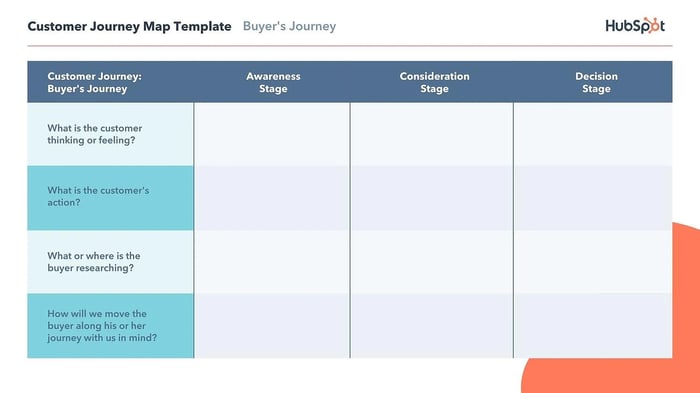
A buyer journey map usually includes customer actions, such as research or a demo request, and how those actions correspond to different stages in the sales funnel. A simple online template can be enough to help you get started identifying the different points in the buyer journey that you can improve.
What are the elements of a buyer experience?
The buyer experience combines elements of psychological motivation, information found throughout the process, and, crucially, the different ways the buyer interacts with your brand and product.
- Buyer’s Psychology and Emotions: Buyer psychology and emotions are the most important elements. They cover the buyer’s desires, needs, wants, and fears. It governs much of what the buyer will experience when making a purchase.
- Information Buyer Consumes: Most buyers consume tons of information (online reviews, articles, demonstrations, etc.) during the process before they even get to a call with a sales rep.
- Interactions During the Buying Process: Your buyers’ interactions with external parties, such as other brands, peers, or journalists, are going to inform how they ultimately interact with your brand.
How is buyer experience different from customer experience?
The buying experience is clearly focused on prospective buyers, whereas the customer experience deals primarily with existing customers. Customer experience begins when the buyer experience ends in a purchase.
The buyer experience differs from the customer experience in a few key ways:
- Focus: Buying experience should focus on revenue-oriented objectives, such as increased conversion rates and shorter buying cycles. Customer experience, on the other hand, focuses on the level of customer satisfaction. Studies show that about 76% of customers would switch to a brand's competitor after a negative customer experience.
- Level of Control: You have less control over the buying experience because it’s about prospective buyers, who are, in most cases, people you don’t know. Businesses have more control over the customer experience because oftentimes, there is already an established relationship with a customer and leading indicators of how satisfied they are with your product.
- Measurement: Buyer experience is often harder to measure than customer experience. Customer experience metrics like Net Promoter Scores (NPS) help understand the customer experience and how it can be improved.
How has the COVID-19 pandemic impacted the buyer experience?
The COVID-19 pandemic will have lasting effects on how business is done around the world. Sales professionals need to be prepared to enter a different world of sales in 2021.
According to the 2020 B2B Buyer Behavior Study from Demand Gen Report, 84% of B2B buyers changed their purchasing plans and behavior, including engagement with potential service providers.
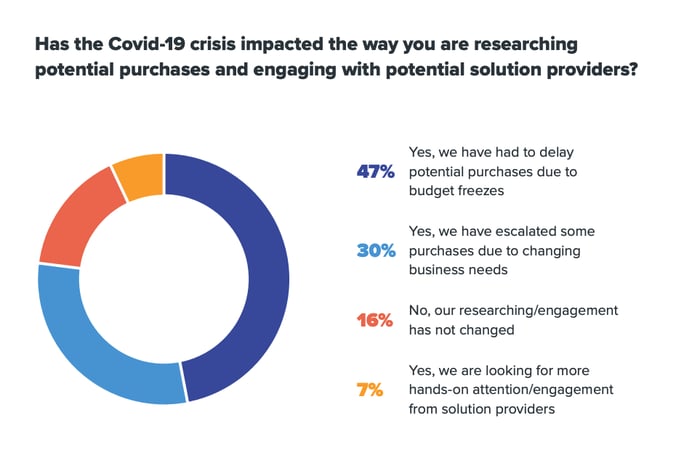
Additionally, 68% of B2B buyers reported that the length of their purchase cycles had increased compared to 2019’s sales cycles.
Sellers should be prepared to adjust their overall buyer experience to account for changes in the purchasing process.
7 benefits of a great buying experience
Delivering a great experience to prospective buyers has the biggest impact on whether or not they will buy something from you.
The overall buying experience actually can make more of a difference than your product and price. If you can provide a great buying experience, you will see:
- More traffic to your website
- More leads coming in
- Higher conversion rates
- Larger average deal size
- Shorter sales cycle
- Lower customer churn
- More referrals when leads become customers
And in return grow 2X faster than your competitors that deliver average experiences!
Why do you need to focus on the buying experience?
A better buyer experience means more opportunities to close deals.
1. Buyers expect tailored experiences
Today’s buyers have access to an unprecedented volume of information. They’re savvier, and they have more options than ever before.
Think of all the ways they can find out about you and your competition: websites, online reviews, social media platforms, industry publications, blogs, and countless other sources. This makes the competitive environment more challenging every day.
Today’s buyers are just like everybody else: They’re trained to expect experiences tailored to their precise needs and diverse interests.
You as a seller have to prove your worth, and encourage them to choose you out of all that competition. Their tipping point often comes down to how well they feel understood—and how well your solution speaks directly to their needs.
2. Buyer journeys are more complex
Buyer journeys used to be fairly straightforward: Shoppers bought from brick-and-mortar stores, catalogs, or websites. B2B buyers went to trade shows, scheduled demos and sat through pitch meetings.
Today’s consumers have a plethora of touchpoints: chatbots, via email, mobile apps, social media platforms, sharing platforms, digital wallets, branded websites, and dozens more.
Whether you are automating outputs or are reaching out personally, each interaction throughout these channels needs to be optimized to minimize confusion, frustration, or overgeneralization.
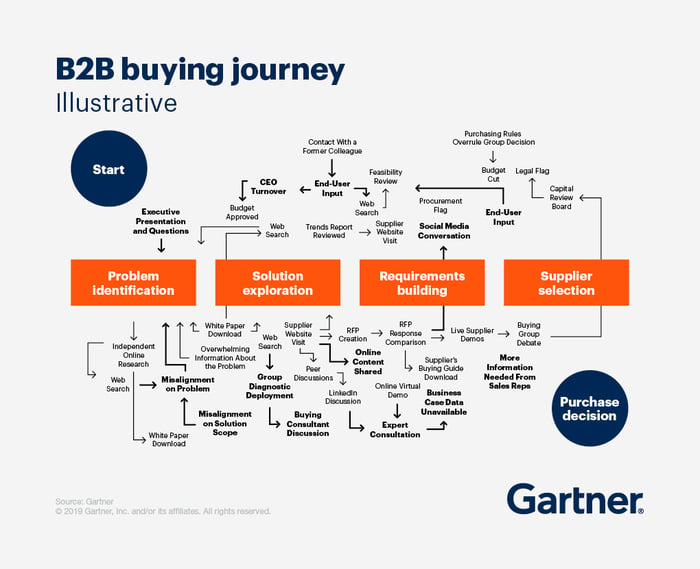
It’s not only the number of touchpoints that increased but also the number of decision-makers you have to persuade.
According to Gartner, the average B2B purchase now involves from 6 to 10 decision-makers. The more people involved, the longer purchasing decisions may take to make, as each decision-maker conducts independent research and information gathering.
Because today’s buyer journey has become so complex, it’s more important than ever that you provide an exceptional and seamless buyer experience to close the deal. At every stage, you need to tailor the experience to your buyer’s needs and motivations.
3. Emotions drive buying decisions
It’s not enough to present your product or service as the solution to prospects’ problems.
Even if you have an intelligent CRM integration, do a better job than your competitors, or have a state-of-the-art feature set, you may not close the deal. You have to make a connection to buyers’ innermost emotional challenges.
Why? Because every part of the buying decision—regardless of the deal size—is emotional. 95% of purchasing decisions are made subconsciously, according to Harvard Business School professor Gerald Zaltman. Reason and logic may form the foundation for the decision to buy, but feelings, intuitions, and trust seal the deal.
For that reason, you have to adopt a buyer-centric approach at every step of your buyer journey.
In a B2B environment, for example, the people who make discovery calls need to ask sophisticated questions to understand the prospect’s pain points. Or in e-commerce, you have to analyze every buyer touchpoint and identify factors like clunky user interfaces and slow-loading web pages that torpedo sales.
How to improve your buyer experience
First things first, you have to understand where your organization’s buyer experience currently stands. By testing your process, interacting with your buyers, and evaluating every touchpoint, you have to find the gaps between:
- What you think your buyers are experiencing
- What they are currently having in reality
- What they want to have
Every buyer wants two things:
- They want help making better decisions
- They want it to be easy to get to and make the final purchasing decision
When designing your experience, you have to focus on moving the buyer to the next step by providing them with what they want and need. This is called buyer-responsive sales and marketing.
Here are 7 actions you can take to improve your buyer experience overall:
1. Become a trusted advisor for your buyer
Sales reps get a bad rap: they’re faced with the stereotype that they’re just trying to trap buyers into losing money.
However, buyers respond positively to reps who can serve as a partner with them. You have to establish your credibility and industry knowledge, and then use that trust to actually help the buyer.
Teach them about best practices. Stay open about other possible solutions. Focus on your buyer’s needs instead of your company’s solution. Be a sales guide, not a solution peddler.
Remember, buyers rate trust as the single most important factor when purchasing products or services, ahead of experience and cost.
Moeed Amin breaks down in more details how build trust with customers in this podcast episode:
2. Build an emotional bond with buyers
B2B buyers say that helpfulness is the most important quality of a sales rep. Despite the many new ways we communicate with each other, buyers still appreciate human interaction.
LinkedIn’s 2020 State of Sales report found that buyers ranked active listening first among the most valued attributes of salespeople. Active listening looks different now when many sales meetings and pitches are happening virtually. Demonstrate active listening over a video call by:
- Keeping your camera on and making sure your face is visible
- Making “eye contact” to the best of your ability
- Staying focused and avoiding distractions on your computer
- Repeating back information to the buyer to demonstrate understanding
Active listening helps you make a deep, heartfelt connection and build an emotional bond with your buyer.
Again, this is about building trust. They want to know there is someone behind the pitch that relates to their needs and whom they can trust to help solve their problems whenever they happen.
Human interaction is not just about knowing the prospect’s name but also making sure you know their business.
3. Personalize sales content
When buyers say they want sales reps who are helpful, they mean helpful specific to their business challenges. That means your sales content needs to reflect not just the industry, but every aspect of the buyer’s business.
Demand Gen Report’s survey also found that 70% of B2B buyers said seeing content relevant to their industry was a very important aspect of a potential service provider’s website.
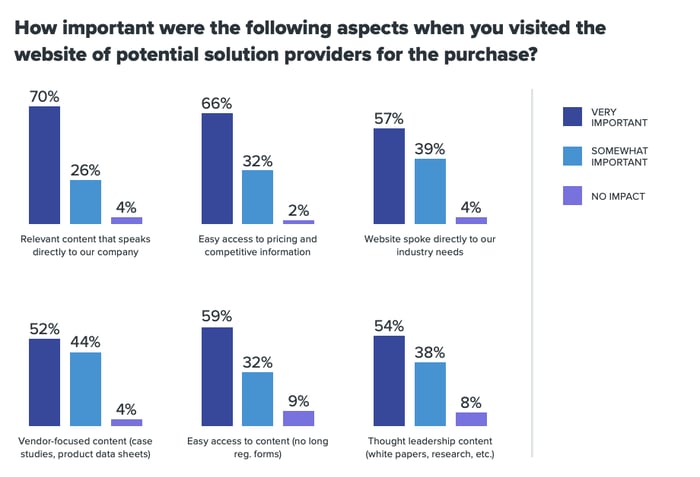
Create sales content that shows in specific terms how your solution will deliver ROI for the buyer. Your sales rep also needs to show up with a full understanding of the buyer’s place in the market. Some examples of custom sales collateral you can create include:
- Personalized videos introducing yourself or following up on a call
- Presentations outlining their specific needs and market position
- Custom proposals tailored to your brand
This is how trust develops. If buyers can see that you’ve done your homework, and your content is specific to them, it will be easier to see you as a partner to their success.
4. Map your prospects’ buying journey
Just because you’re at the discovery stage in your sales cycle doesn’t mean your buyer is too. You need to align your sales process steps to match your buyer’s journey.
By mapping your buyer’s journey, you can provide much more useful insight, which will lead to higher sales engagement.
In order to do that, you should design and implement specific sales engagements that are truly buyer-responsive, and make sure you have content to match the whole buying journey.
5. Respond to your leads quickly
Don’t let slow follow-up times make leads go cold. B2B buyers need information in a day or less in order to make an effective decision.
But unfortunately, many reps can’t respond quickly because they’re either too busy doing other tasks, they don’t know when the buyer is showing interest, or they don’t have the tools to personalize sales resources for their buyers. You might consider using a Digital Sales Room to solve this problem.
6. Show value for your buyer
According to CEB, B2B buyers who see personal value in a purchase are 71% more likely to buy. Maybe that’s why you should stop focusing on features and start focusing on outcomes.
How will your buyers benefit from this purchase? Will it make their jobs easier? Improve their standing among peers? By communicating value (see Harvard Business’ Value Pyramid) at the organizational and individual buyer level, you’ll be able to increase buyer engagement.
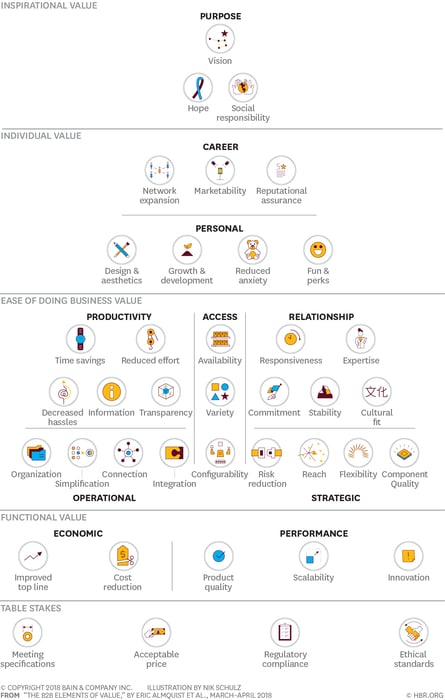
7. Support your evangelist
Your prospect is most likely part of a buying team, which means that they have to convince the other members that your solution is the right choice.
According to a 2016 whitepaper from CEB, reaching a team-wide agreement on a decision is 81% harder than making up their own mind. So, you have to make it easy for your evangelist to advocate for you, and they’ll make the selling process easier on you.
The buyer experience makes the difference between lost and won deals
As selling becomes increasingly digital and prospects have more knowledge at their fingertips, businesses must create high-quality buyer experiences that set their product apart from competitors.
B2B sellers need to understand what buyers are thinking and what they want to evaluate the end-to-end buying experience from both sides of the table.
For more buyer experience tips from leaders at HubSpot and G2, check out our webinar, "The Other Side of the Table: What Buyers Really Want."



